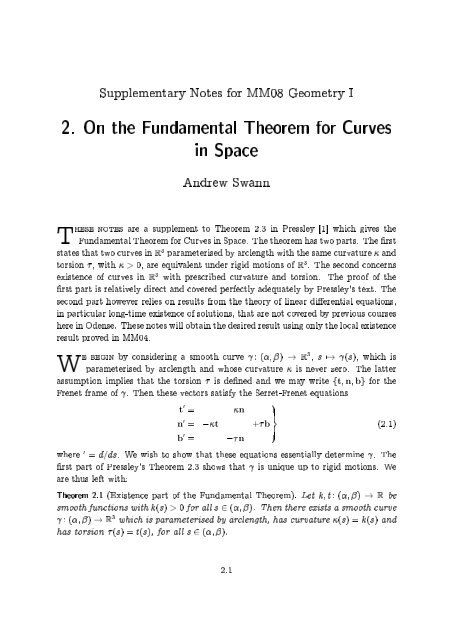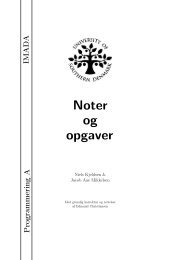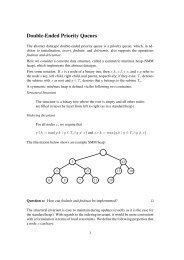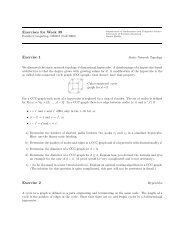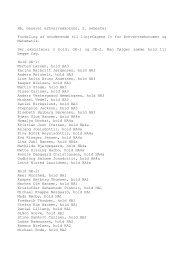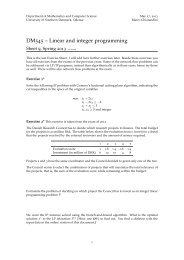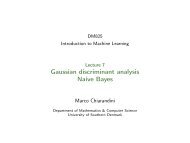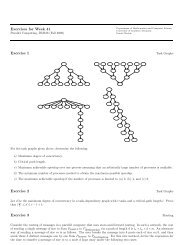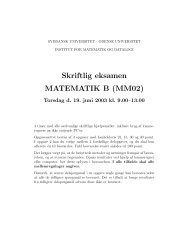2. On the Fundamental Theorem for Curves in Space
2. On the Fundamental Theorem for Curves in Space
2. On the Fundamental Theorem for Curves in Space
Create successful ePaper yourself
Turn your PDF publications into a flip-book with our unique Google optimized e-Paper software.
Supplementary Notes <strong>for</strong> MM08 Geometry I<br />
<strong>2.</strong> <strong>On</strong> <strong>the</strong> <strong>Fundamental</strong> <strong>Theorem</strong> <strong>for</strong> <strong>Curves</strong><br />
<strong>in</strong> <strong>Space</strong><br />
Andrew Swann<br />
These notes are a supplement to <strong>Theorem</strong> <strong>2.</strong>3 <strong>in</strong> Pressley [1] which gives <strong>the</strong><br />
<strong>Fundamental</strong> <strong>Theorem</strong> <strong>for</strong> <strong>Curves</strong> <strong>in</strong> <strong>Space</strong>. The <strong>the</strong>orem has two parts. The rst<br />
states that two curves <strong>in</strong> R 3 parameterised by arclength with <strong>the</strong> same curvature and<br />
torsion , with > 0, are equivalent under rigid motions of R 3 . The second concerns<br />
existence of curves <strong>in</strong> R 3 with prescribed curvature and torsion. The proof of <strong>the</strong><br />
rst part is relatively direct and covered perfectly adequately by Pressley's text. The<br />
second part however relies on results from <strong>the</strong> <strong>the</strong>ory of l<strong>in</strong>ear dierential equations,<br />
<strong>in</strong> particular long-time existence of solutions, that are not covered by previous courses<br />
here <strong>in</strong> Odense. These notes will obta<strong>in</strong> <strong>the</strong> desired result us<strong>in</strong>g only <strong>the</strong> local existence<br />
result proved <strong>in</strong> MM04.<br />
We beg<strong>in</strong> by consider<strong>in</strong>g a smooth curve : (; ) ! R 3 , s 7! (s), which is<br />
parameterised by arclength and whose curvature is never zero. The latter<br />
assumption implies that <strong>the</strong> torsion is dened and we may write ft; n; bg <strong>for</strong> <strong>the</strong><br />
Frenet frame of . Then <strong>the</strong>se vectors satisfy <strong>the</strong> Serret-Frenet equations<br />
9>=<br />
t 0 = n<br />
n 0 >;<br />
= t +b<br />
(<strong>2.</strong>1)<br />
b 0 = n<br />
where 0 = d=ds. We wish to show that <strong>the</strong>se equations essentially determ<strong>in</strong>e . The<br />
rst part of Pressley's <strong>Theorem</strong> <strong>2.</strong>3 shows that is unique up to rigid motions. We<br />
are thus left with:<br />
<strong>Theorem</strong> <strong>2.</strong>1 (Existence part of <strong>the</strong> <strong>Fundamental</strong> <strong>Theorem</strong>). Let k; t : (; ) ! R be<br />
smooth functions with k(s) > 0 <strong>for</strong> all s 2 (; ). Then <strong>the</strong>re exists a smooth curve<br />
: (; ) ! R 3 which is parameterised by arclength, has curvature (s) = k(s) and<br />
has torsion (s) = t(s), <strong>for</strong> all s 2 (; ).<br />
<strong>2.</strong>1
To start <strong>the</strong> proof, let us look at <strong>the</strong> Serret-Frenet system (<strong>2.</strong>1) <strong>in</strong> matrix <strong>for</strong>m.<br />
Regard<strong>in</strong>g t, n and b<br />
0<br />
as row<br />
1<br />
vectors<br />
0<br />
we have<br />
1 1<br />
B@ t n<br />
b<br />
CA0<br />
We <strong>the</strong>re<strong>for</strong>e consider <strong>the</strong> equations<br />
<strong>for</strong> V : (; ) ! M 3 (R) with<br />
A(s) =<br />
=<br />
B@ 0 CA 0 B@ 0 t n<br />
0 <br />
0 0<br />
b<br />
CA : (<strong>2.</strong>2)<br />
V 0 = AV (<strong>2.</strong>3)<br />
0<br />
B@ 0 (s) 0<br />
(s) 0 (s)<br />
0 (s) 0<br />
1<br />
CA : (<strong>2.</strong>4)<br />
<strong>On</strong>e may get local existence of solutions to (<strong>2.</strong>3) with prescribed <strong>in</strong>itial data,<br />
by apply<strong>in</strong>g <strong>the</strong> follow<strong>in</strong>g <strong>the</strong>orem from MM04 (Supplerende noter til punktmængdetopologi,<br />
Sætn<strong>in</strong>g <strong>2.</strong>2, side 6):<br />
<strong>Theorem</strong> <strong>2.</strong><strong>2.</strong> Let B R n+1 be an open set. Suppose f : B ! R n , (s; x) 7! f (s; x)<br />
is a cont<strong>in</strong>uous function whose partial derivatives @f=@x j , j = 1; : : : ; n, exist and<br />
are cont<strong>in</strong>uous <strong>in</strong> B.<br />
Fix a po<strong>in</strong>t (s 0 ; x 0 ) <strong>in</strong> B. Then <strong>the</strong> dierential equation<br />
x 0 (s) = f (s; x(s))<br />
with <strong>in</strong>itial condition<br />
x(s 0 ) = x 0 ;<br />
has a unique solution x(s) with s <strong>in</strong> an <strong>in</strong>terval (s 0 "; s 0 + ") <strong>for</strong> some " > 0.<br />
To apply this to (<strong>2.</strong>3), note that M 3 (R) = R 9 , so take n = 9 and put<br />
f (s; V ) = A(s)V;<br />
B = (; ) ¢ M 3 (R):<br />
As <strong>the</strong> entries of A are smooth <strong>in</strong> s, <strong>the</strong> required partial derivatives of f exist and are<br />
smooth. Thus, we have local solutions to (<strong>2.</strong>3) around any given po<strong>in</strong>t s 0 2 (; )<br />
with any given <strong>in</strong>itial data V 0 2 M 3 (R).<br />
<strong>2.</strong>2
F<br />
or<br />
two solutions V 1 and V 2 to (<strong>2.</strong>3) on some sub<strong>in</strong>terval of ( 0 ; 0 ) (; ),<br />
consider <strong>the</strong> matrix V T<br />
2<br />
V 1<br />
obta<strong>in</strong>ed by multiply<strong>in</strong>g <strong>the</strong> transpose of V 2 onto V 1 .<br />
Dierentiat<strong>in</strong>g we have<br />
(V T<br />
2<br />
V 1<br />
) 0 = (V 0<br />
2 )T V 1<br />
+ V T<br />
2<br />
V 0<br />
1 = (AV 2) T V 1<br />
+ V T<br />
2 (AV 1 ) = V T<br />
2 (AT + A)V 1<br />
= 0;<br />
s<strong>in</strong>ce A <strong>in</strong> (<strong>2.</strong>4) skew-symmetric. We have thus proved<br />
Lemma <strong>2.</strong>3. Suppose V 1 and V 2 satisfy V 0<br />
i<br />
= AV i<br />
, i = 1; 2 on ( 0 ; 0 ) with A as<br />
<strong>in</strong> (<strong>2.</strong>4). Then V T<br />
2<br />
V 1<br />
is constant on ( 0 ; 0 ).<br />
Fix a po<strong>in</strong>t s 0 2 (; ) and let V be <strong>the</strong> maximal solution to (<strong>2.</strong>3) with <strong>in</strong>itial<br />
condition V (s 0 ) = Id, where Id is <strong>the</strong> (3 ¢ 3) identity matrix. Here maximal<br />
means that V is dened on some sub<strong>in</strong>terval ( 0 ; 0 ) of (; ) and that <strong>the</strong>re is no<br />
such solution dened on a larger sub<strong>in</strong>terval. Our aim is to prove that ( 0 ; 0 ) = (; ).<br />
Lemma <strong>2.</strong>4. V (s) is an orthogonal matrix <strong>for</strong> each s 2 ( 0 ; 0 ), i.e.,<br />
V T (s)V (s) = Id :<br />
Proof. By Lemma <strong>2.</strong>3, V T V is constant on ( 0 ; 0 ). At s 0 it has value Id T Id = Id.<br />
Lemma <strong>2.</strong>5. The set<br />
O(3) = f X 2 M 3 (R) : X T X = Id g<br />
of orthogonal matrices is a compact subset of M 3 (R).<br />
Proof. If X is orthogonal, <strong>the</strong>n each column x i of X is a unit vector <strong>in</strong> R 3 . Thus as<br />
vector <strong>in</strong> R 9 , X has length kx 1 k 2 + kx 2 k 2 + kx 3 k 2 = 3. So O(3) is bounded <strong>in</strong> M 3 (R).<br />
The function F : M 3 (R) ! M 3 (R) given by F (X) = X T X is cont<strong>in</strong>uous, so O(3) =<br />
F 1 (fIdg) is closed. There<strong>for</strong>e, O(3) is closed and bounded and hence compact.<br />
Suppose 0 < . Let (~s i ) 1 i=1 be a sequence of po<strong>in</strong>ts <strong>in</strong> ( 0; 0 ) converg<strong>in</strong>g to 0 .<br />
Then as V (~s i ) lie <strong>in</strong> <strong>the</strong> compact set O(3), <strong>the</strong>re is a subsequence (s n ) 1 n=0<br />
and a po<strong>in</strong>t<br />
~V 2 O(3) such that<br />
V (s n ) ! ~ V as n ! 1:<br />
Let W be a solution of <strong>the</strong> system (<strong>2.</strong>3) with <strong>in</strong>itial condition W ( 0 ) = V ~ . Then W (s)<br />
is dened on some <strong>in</strong>terval ( 1 ; 1 ) around 0 . We may assume 1 > 0 . Then on<br />
( 1 ; 0 ) we have by Lemma <strong>2.</strong>3 that W T V is constant. However, (W T V )(s n ) ! V ~ T ~V =<br />
Id as n ! 1, so W T V = Id on ( 1 ; 0 ). Now V is orthogonal, so W = (V T ) 1 = V<br />
on this <strong>in</strong>terval. Putt<strong>in</strong>g<br />
^V (s) =(<br />
V (s) 0 < s < 0 ;<br />
W (s) 0 6 s < 1 ;<br />
<strong>2.</strong>3
we thus obta<strong>in</strong> a solution to <strong>the</strong> equations (<strong>2.</strong>3), with <strong>in</strong>itial value Id at s = s 0 , on <strong>the</strong><br />
larger <strong>in</strong>terval ( 0 ; 1 ). This contradicts <strong>the</strong> maximality of V and we conclude that<br />
0 = . A similar argument shows 0 = and thus our maximal solution V is dened<br />
on <strong>the</strong> whole of (; ).<br />
To conclude <strong>the</strong> proof of <strong>Theorem</strong> <strong>2.</strong>1,<br />
0<br />
write<br />
1<br />
our maximal solution V as<br />
B@ t CA V = n :<br />
b<br />
Put<br />
(s) =<br />
Z<br />
s<br />
s 0<br />
t(u) du:<br />
Then : (; ) ! R 3 is a curve with 0 = t. As V is orthogonal, we have V 1 = V T ,<br />
so V V T = Id show<strong>in</strong>g that ft; n; bg is orthonormal. In particular, t is a unit vector<br />
and is parameterised by arclength. We now have t 0 = kn, so = k and n is <strong>the</strong><br />
normal to . Now b is proportional to t ¢ n with ht ¢ n; bi = det(V ). For V 2 O(3),<br />
1 = det(Id) = det(V T V ) = det(V T ) det(V ) = det(V ) 2 , so det V = ¦1. As det V (s)<br />
is cont<strong>in</strong>uous on (; ) and det V (s 0 ) = det Id = 1, we have det V (s) = 1 <strong>for</strong> all s,<br />
b = t ¢ n, and b is <strong>the</strong> b<strong>in</strong>ormal. F<strong>in</strong>ally, b 0 = tn shows = t, as required.<br />
References<br />
[1] A. Pressley, Elementary dierential geometry, Spr<strong>in</strong>ger Undergraduate Ma<strong>the</strong>matics<br />
Series, Spr<strong>in</strong>ger-Verlag London Ltd., London, 2001.<br />
<strong>2.</strong>4


